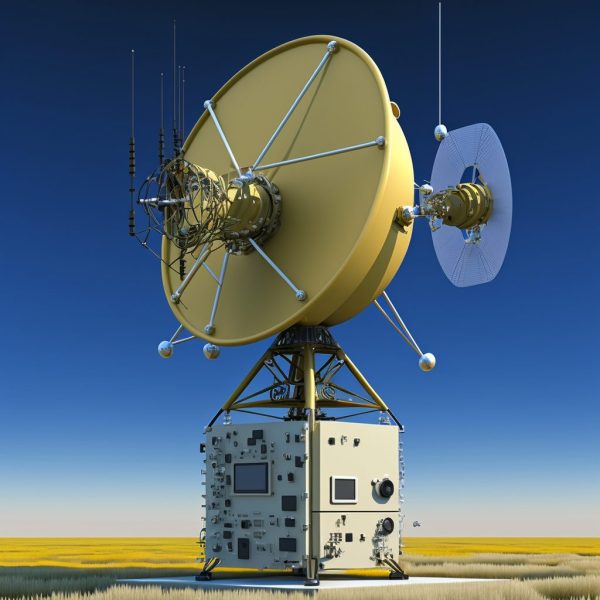Disclaimer
This article is an experiment with new revolutionary technologies: Open AI Chart GPT-3 and MidJourney. The title, structure, content, and illustrations of this article were fully generated by artificial intelligence. While we guided the systems and directed them using recent industry news and a description of our system, we made no manual edits and simply copy-pasted the generated content.
Awesome outcome! AI is going to change our lives, hopefully for the better 🙂
Introduction
Global Navigation Satellite Systems (GNSS) have become an essential part of our daily lives, providing precise positioning and timing information for a wide range of applications, including aviation, maritime navigation, financial services, and many others. However, the increasing reliance on GNSS has also made it a prime target for malicious actors looking to disrupt or manipulate the system. This is where GNSS interference monitoring and classification comes in.
Threats to GNSS
GNSS interference refers to any kind of disturbance that affects the normal functioning of GNSS-based navigation systems. It can be divided into two main categories: jamming and spoofing.
Jamming is the intentional or unintentional emission of radio frequency signals that interfere with the normal operation of GNSS receivers. The signals can be generated by a variety of sources, including radio transmitters, electronic devices, and even solar flares. Jamming can cause GNSS receivers to lose their ability to determine their position, velocity, and time, leading to navigation errors and loss of safety-critical information.
Spoofing, on the other hand, is a type of GNSS interference that involves the deliberate transmission of false GNSS signals. The false signals can be designed to mimic the real GNSS signals and trick GNSS receivers into providing incorrect navigation information.
Despite the growing threat, policymakers in many countries are failing to address the issue of GNSS interference.
In recent years, there have been several high-profile incidents of GPS jamming and spoofing. For example, in 2019, a passenger aircraft nearly crashed near Sun Valley, Idaho due to GPS jamming. In January 2022, pilots at Denver International reported safety concerns during a jamming incident, and in October 2022, jamming near Dallas-Fort Worth disrupted traffic and caused gate delays. Despite the efforts of investigators, the sources of these incidents were never found.
GPS jamming is a serious problem that affects virtually every mode of transportation and technology. The US government has recognized the issue since 2001, but funding for the Department of Transportation to make civil users safer has been minimal. Meanwhile, countries like China, South Korea, Russia, Saudi Arabia, Iran, and the UK have ground-based GPS-like systems that are less vulnerable to interference.
In Norway, GPS signals are regularly jammed in the country’s far north by Russia. This has led Norway to take steps to strengthen its defense, including making its largest ammunition buy ever and sending ammunition to Ukraine to help train its army. Norway is particularly vulnerable to jamming because it relies on the Galileo satnav system, which could be easily blocked by Russian jamming. Russia, on the other hand, is less vulnerable due to its own version of GPS (GLONASS) and a high-power terrestrial navigation system (Chaika).
People use GNSS jammers for various reasons, including fraud against fleet management or other tracking systems, privacy concerns, and fraud against distance-based road user charging and vehicle insurance systems. Despite the fact that the use of GNSS jammers is prohibited in all developed countries, they can still be easily purchased online, even on Amazon, for as little as $15.
In conclusion, GNSS interference remains a serious threat to safe and efficient transportation, especially aviation. Policymakers need to take the issue seriously and take steps to address it, including improving responses to GPS jamming incidents and increasing protection for all forms of transportation.
Consequences of GNSS Interference
GNSS interference can have serious consequences for both the economy and public safety. When GNSS signals are disrupted, the results can be widespread and far-reaching, affecting everything from critical infrastructure to everyday activities.
A. Economic Impact
The economic impact of GNSS interference can be substantial. Disruptions to GNSS signals can result in the loss of revenue for businesses, as well as the disruption of critical services that rely on GNSS technology. For example, if a shipping company’s GNSS signals are disrupted, it could result in delayed shipments and lost business.
B. Safety Impact
The safety impact of GNSS interference can be even more severe. In the aviation industry, GNSS signals are used to determine the position and altitude of aircraft, making them crucial for safe flight operations. If GNSS signals are disrupted, it could result in a loss of control and a potential crash.
In the maritime industry, GNSS signals are used for navigation and safety, and disruptions to these signals could result in ships losing their way and putting lives at risk.
C. National Security Impact
GNSS interference can have serious consequences for critical infrastructure systems, such as banks, stock exchanges, telecoms, and televisions, as well as national security. When GNSS signals are spoofed, fake time is introduced into these systems, causing disruptions and affecting their reliability. For example, fake time can disrupt financial transactions and compromise financial data, cause network outages in the telecom sector, and impact navigation in the aviation and maritime industries, increasing the risk of accidents. In addition, GNSS interference can conceal the movements of malicious actors, making it difficult for authorities to monitor and respond to potential threats, which could have serious consequences for national security. To prevent these consequences, it is crucial to monitor and classify GNSS interference in a timely and effective manner.
The Importance of GNSS Interference Monitoring and Classification
In order to effectively mitigate the consequences of GNSS interference, it’s crucial to have a deep understanding of the scope of the problem. This includes knowing the frequency and duration of incidents, as well as which GNSS constellations are affected. Without this information, it’s difficult to choose the right countermeasures to address the issue.
That’s why GNSS interference monitoring and classification systems are so important. These systems provide the necessary data to make informed decisions about how to mitigate the consequences of GNSS interference. By gathering statistics on incidents, decision-makers can gain a deep understanding of the problem and take the right steps to address it.
GPSPATRON GNSS Interference Detection and Classification Solution
GPSPATRON provides an all-in-one platform for real-time GNSS interference monitoring, classification, and localization. The system consists of a three-channel GNSS probe (GP-Probe) and a cloud service (GP-Cloud). GP-Probe conducts GNSS signal measurements and sends raw data to GP-Cloud for real-time processing, using anomaly detection and classification algorithms.
Key features of GPSPATRON include:
- Three-channel probe and spatial signal analysis detect deliberate GNSS spoofing attacks.
- True real-time processing with spoofing detection latency of less than three seconds.
- Supports GPS, GLONASS, Galileo, and BeiDou.
- GP-Cloud web application allows for control of all GNSS-dependent entities.
- Unlimited scalability and low false-positive rate for spoofing detection in real-live urban environments.
GPSPATRON protects GNSS-dependent infrastructure from GNSS spoofing, jamming, and other signal anomalies that degrade time and position accuracy. Applications include time server protection, GNSS signal quality monitoring, interference detection and classification, and anomaly detection in RTK base station data.
Conclusion
In conclusion, GNSS interference is a rapidly growing issue with potentially devastating consequences. To effectively mitigate these threats, it’s essential to have a comprehensive understanding of both jamming and spoofing events. Unfortunately, without accurate statistics on the frequency and nature of these events, it can be difficult to develop effective mitigation measures.
That’s where our solution comes in. GPSPATRON solution provides real-time monitoring and classification of GNSS interference, enabling you to quickly detect and respond to threats. By leveraging cutting-edge technology and a deep understanding of the GNSS landscape, we believe that our solution can help you safeguard your critical infrastructure and minimize the impact of GNSS interference.





